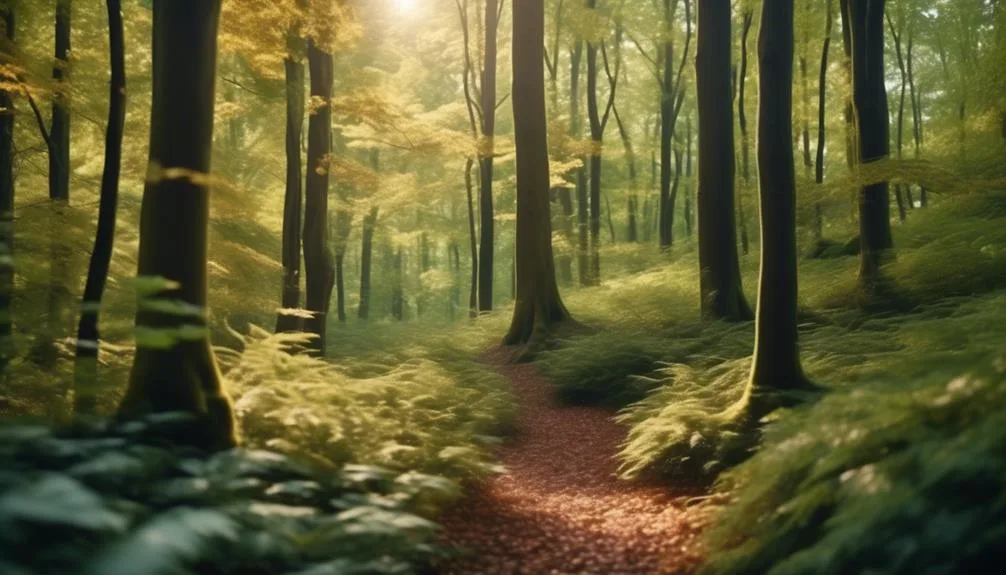Beech trees can thrive for over 300 years in a forest. They play a vital role in maintaining the environment's balance and health.
From providing shelter and food for various wildlife to enriching the soil and capturing carbon, beech trees are remarkable. Their influence extends to impacting the intricate web of forest life.
Understanding the role of beech trees in the ecosystem reveals the interconnectedness of nature and the importance of these iconic trees.
Role of Beech Trees in Forest Ecosystems
Beech trees play a crucial role in forest ecosystems, providing habitat for a diverse range of flora and fauna while also contributing to the overall health and stability of the ecosystem.
Their dense canopy and shallow root systems create an environment that challenges the growth of other plants, leading to intense competition for resources. This competition influences the composition and structure of the forest, shaping the diversity and abundance of species within it.
Additionally, beech tree regeneration dynamics play a significant role in the forest's long-term sustainability. Their ability to produce viable seeds in large quantities during mast years, followed by periods of low seed production, affects the population dynamics of the species within the ecosystem.
Understanding these dynamics is crucial for managing and conserving the delicate balance of forest ecosystems where beech trees thrive.
Beech Trees as Keystone Species
Playing a fundamental role in maintaining the intricate balance of their forest ecosystem, beech trees are considered keystone species due to their significant impact on the biodiversity and dynamics of the environment. Here's why:
- Canopy Dominance: Beech trees often form a dense, persistent canopy that shades out other competing species, shaping the overall structure and composition of the forest.
- Seed Dispersal: Beech trees play a crucial role in seed dispersal by producing an abundance of seeds that serve as a vital food source for many forest-dwelling organisms, thus influencing the distribution and abundance of various species.
- Ecosystem Stability: Their presence and interactions with other species contribute to the stability and resilience of the forest ecosystem, making them a keystone species essential for its overall health and function.
Impact of Beech Trees on Biodiversity
With their widespread presence and influential role in shaping forest dynamics, beech trees have a profound impact on the biodiversity of their ecosystem. These tree species support a rich variety of flora and fauna, contributing significantly to the overall ecosystem resilience.
The dense canopy of beech trees creates a unique microhabitat, providing shelter and foraging opportunities for numerous species of birds, mammals, insects, and fungi. Additionally, the leaf litter from beech trees enriches the soil, promoting the growth of diverse understory vegetation and contributing to the overall richness of the forest floor.
Beech trees also play a crucial role in shaping the competitive dynamics among species, influencing the composition and distribution of other plants within the ecosystem. Their presence not only fosters biodiversity but also contributes to the overall health and balance of the forest ecosystem.
Beech Trees and Soil Health
Enriching the soil with vital nutrients, beech trees contribute significantly to the overall health and fertility of the forest ecosystem. Here's how they impact soil health:
- Nutrient Cycling: Beech trees play a crucial role in cycling nutrients through the soil. Their fallen leaves and twigs decompose, releasing essential nutrients back into the soil, which promotes the growth of other plants and microorganisms.
- Soil Fertility: Beech trees enhance soil fertility by contributing organic matter, which improves soil structure and water retention. This creates a favorable environment for a diverse range of soil organisms, further enriching the ecosystem.
- Sustainable Ecosystem: By maintaining soil fertility, beech trees support a sustainable ecosystem where various flora and fauna can thrive, ultimately contributing to the overall health and balance of the forest.
Beech Trees' Contribution to Carbon Sequestration
Beech trees actively sequester carbon from the atmosphere, playing a crucial role in mitigating climate change and maintaining the ecological balance of the forest ecosystem. Their dense wood and extensive root systems enable them to store significant amounts of carbon, helping to reduce the concentration of greenhouse gases in the atmosphere. Additionally, beech tree wood products, such as furniture and flooring, continue to store carbon even after the tree has been harvested. This long-term storage of carbon in wood products further contributes to mitigating climate change. The following table illustrates the carbon sequestration potential of beech trees:
| Carbon Sequestration Component | Beech Trees |
|---|---|
| Above-Ground Biomass | High |
| Below-Ground Biomass | High |
| Wood Products | Significant |
| Soil | Moderate |
| Total | Substantial |
Beech trees play a vital role in addressing climate change through their carbon sequestration capabilities and the long-term storage of carbon in their wood products.
Conclusion
In essence, the beech trees stand as guardians of the forest, nurturing life, enriching the soil, and combating climate change. Their significance extends beyond the woodland, shaping the delicate balance of nature.
How might our forests evolve without these majestic trees as their steadfast stewards?

My interest in trees started when I first saw the giant sequoias in Yosemite.
I was a teenager then, and I remember thinking, “I need to learn more about this.”
That moment stuck with me.
A few years later, I went on to study forestry at Michigan Tech.
Since graduating, I’ve worked in a mix of hands-on tree care and community education.
I’ve spent over ten years helping people understand how to plant, maintain, and protect the trees in their neighborhoods.
I don’t see trees as just part of the landscape.
They are living things that make a real difference in our daily lives.
